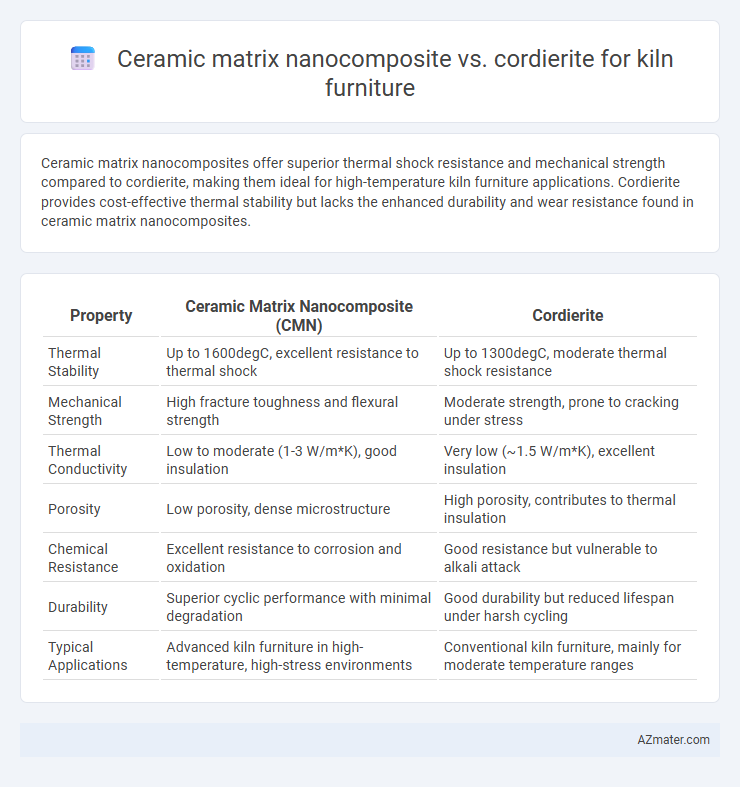Ceramic matrix nanocomposites offer superior thermal shock resistance and mechanical strength compared to cordierite, making them ideal for high-temperature kiln furniture applications. Cordierite provides cost-effective thermal stability but lacks the enhanced durability and wear resistance found in ceramic matrix nanocomposites.
Table of Comparison
| Property | Ceramic Matrix Nanocomposite (CMN) | Cordierite |
|---|---|---|
| Thermal Stability | Up to 1600degC, excellent resistance to thermal shock | Up to 1300degC, moderate thermal shock resistance |
| Mechanical Strength | High fracture toughness and flexural strength | Moderate strength, prone to cracking under stress |
| Thermal Conductivity | Low to moderate (1-3 W/m*K), good insulation | Very low (~1.5 W/m*K), excellent insulation |
| Porosity | Low porosity, dense microstructure | High porosity, contributes to thermal insulation |
| Chemical Resistance | Excellent resistance to corrosion and oxidation | Good resistance but vulnerable to alkali attack |
| Durability | Superior cyclic performance with minimal degradation | Good durability but reduced lifespan under harsh cycling |
| Typical Applications | Advanced kiln furniture in high-temperature, high-stress environments | Conventional kiln furniture, mainly for moderate temperature ranges |
Introduction to Kiln Furniture Materials
Ceramic matrix nanocomposites (CMNCs) offer superior thermal shock resistance and higher mechanical strength compared to traditional cordierite materials used in kiln furniture. Cordierite, valued for its low thermal expansion and good thermal shock resistance, remains widely used due to cost-effectiveness and ease of fabrication. Advances in CMNCs incorporate nanoscale reinforcements that enhance durability and extend service life under extreme kiln temperatures exceeding 1300degC.
Overview of Ceramic Matrix Nanocomposites
Ceramic matrix nanocomposites (CMNs) consist of a ceramic matrix reinforced with nanoscale particles, enhancing mechanical strength, thermal stability, and resistance to thermal shock compared to traditional cordierite used in kiln furniture. These nanocomposites exhibit superior fracture toughness and creep resistance, making them ideal for high-temperature kiln applications where durability and longevity are critical. Their improved microstructural properties contribute to more efficient thermal insulation and reduced energy consumption during kiln operation.
Properties and Composition of Cordierite
Cordierite, a magnesium iron aluminum cyclosilicate with the chemical formula (Mg,Fe)2Al4Si5O18, offers low thermal expansion, high thermal shock resistance, and excellent chemical stability, making it ideal for kiln furniture applications. Compared to ceramic matrix nanocomposites (CMNCs), which incorporate nanoscale reinforcements to enhance mechanical strength and fracture toughness, cordierite provides superior dimensional stability under repeated high-temperature cycles. Its composition, predominated by cordierite crystals with minor glassy phases, ensures minimal thermal deformation and prolonged service life in kiln environments.
Thermal Stability Comparison
Ceramic matrix nanocomposites exhibit superior thermal stability compared to cordierite, maintaining structural integrity at temperatures exceeding 1400degC while cordierite typically withstands up to 1280degC. The enhanced thermal shock resistance and lower thermal conductivity of ceramic matrix nanocomposites reduce deformation and cracking during rapid heating and cooling cycles in kiln environments. These properties make ceramic matrix nanocomposites more suitable for high-temperature applications requiring prolonged thermal exposure and mechanical durability.
Mechanical Strength Analysis
Ceramic matrix nanocomposites exhibit superior mechanical strength compared to cordierite, with enhanced fracture toughness and flexural strength crucial for kiln furniture applications. Nanocomposites demonstrate improved resistance to thermal shock and mechanical loads due to the nanoscale reinforcement phase, which hinders crack propagation and increases durability under high-temperature cycling. Cordierite, while possessing excellent thermal stability and low thermal expansion, generally offers lower mechanical strength that limits its lifespan in demanding kiln environments.
Resistance to Thermal Shock
Ceramic matrix nanocomposites exhibit significantly higher resistance to thermal shock compared to cordierite, making them ideal for kiln furniture exposed to rapid temperature fluctuations. The nanocomposites' enhanced toughness and thermal conductivity reduce the risk of cracking and extend service life under harsh firing cycles. Cordierite, while thermally stable, has lower fracture toughness and slower thermal conductivity, limiting its performance in high thermal shock environments.
Lifespan and Durability Performance
Ceramic matrix nanocomposites exhibit superior lifespan and durability performance compared to cordierite in kiln furniture applications due to their enhanced thermal shock resistance and higher mechanical strength. The integration of nanoparticles in ceramic matrices improves fracture toughness and reduces crack propagation, resulting in extended service life under cyclic high-temperature conditions. Cordierite, while offering good thermal stability and low thermal expansion, typically suffers from lower mechanical durability and shorter operational lifespan when exposed to aggressive kiln environments.
Energy Efficiency in Firing Processes
Ceramic matrix nanocomposites exhibit superior thermal conductivity and lower thermal expansion compared to cordierite, resulting in faster heat transfer and reduced energy consumption during firing processes. Their enhanced resistance to thermal shock and longer service life minimize downtime and kiln rebuilding, optimizing overall energy efficiency. Cordierite, while thermally stable, generally requires longer firing cycles and higher energy input to achieve comparable results in kiln furniture applications.
Cost Comparison and Economic Viability
Ceramic matrix nanocomposites (CMNCs) typically exhibit higher initial costs compared to cordierite due to advanced manufacturing processes and raw material expenses. Cordierite, known for its low thermal expansion and cost-effectiveness, remains economically viable for large-scale kiln furniture applications. Despite higher upfront costs, CMNCs offer superior mechanical strength and thermal shock resistance, potentially reducing long-term replacement and maintenance expenses, impacting overall economic feasibility.
Future Trends and Material Innovations
Ceramic matrix nanocomposites (CMNCs) exhibit superior thermal stability and enhanced fracture toughness compared to traditional cordierite, enabling extended kiln furniture lifespan at higher operating temperatures. Emerging material innovations include nano-scale reinforcement additives that improve mechanical strength and thermal shock resistance, addressing critical limitations of cordierite under rapid temperature cycling. Future trends emphasize the integration of multifunctional nanomaterials to enhance thermal conductivity and chemical inertness, driving the next generation of high-performance, energy-efficient kiln furniture.

Infographic: Ceramic matrix nanocomposite vs Cordierite for Kiln furniture
 azmater.com
azmater.com